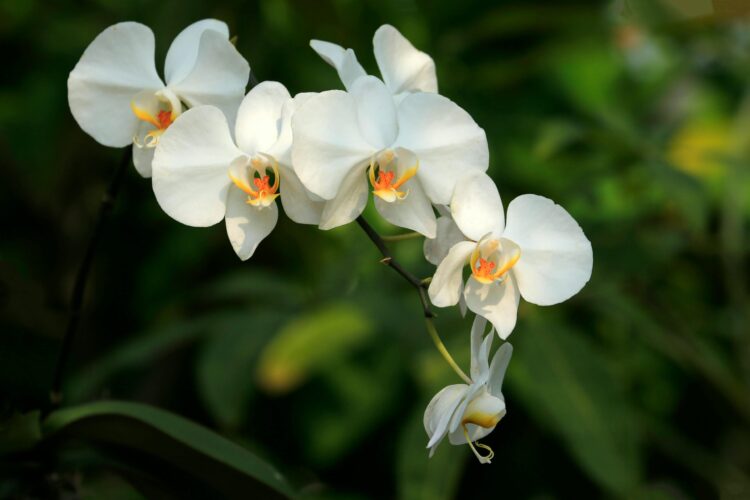Orchids are renowned for their elegance and diversity, captivating enthusiasts with their beauty and mystery. Among the vast array of orchid species, Bulbophyllum Auratum stands out with its unique charm and intricate features. If you’re a novice orchid enthusiast looking to embark on the journey of nurturing these delicate blooms, you’ve come to the right place. In this beginner’s manual, we’ll delve into the essentials of Bulbophyllum Auratum care, ensuring a rewarding and fulfilling experience for both you and your orchid.

Understanding Bulbophyllum Auratum:
Before diving into care instructions, let’s get acquainted with Bulbophyllum Auratum. Originating from the tropical regions of Asia, this orchid species is prized for its vibrant colors, distinct patterns, and captivating fragrance. Characterized by its pseudobulbs, which store water and nutrients, and its intricate flowers, Bulbophyllum Auratum presents a delightful challenge for orchid enthusiasts seeking to cultivate something extraordinary.
Lighting requirements Bulbophyllum Auratum
Bulbophyllum Auratum thrives in bright, indirect light. Place your orchid near a window with filtered sunlight to provide the optimal lighting conditions. Direct sunlight can be too intense and may lead to sunburn, especially for the delicate foliage of Bulbophyllum Auratum. If natural light is insufficient, you can supplement it with artificial lighting using fluorescent or LED grow lights, positioned about 12-18 inches above the orchid.
Aim for a lighting duration of 10-12 hours per day to mimic natural daylight cycles. Regularly monitor the orchid for signs of light stress, such as yellowing or bleaching of leaves, and adjust the lighting intensity accordingly. Remember, striking the right balance of light is crucial for the health and blooming of your Bulbophyllum Auratum.
Temperature
Maintaining moderate temperatures is essential for the health and well-being of Bulbophyllum Auratum. This orchid species thrives in temperatures ranging from 60°F to 80°F (15°C to 27°C) during the day, with a slight drop at night. Avoid exposing your orchid to extreme temperature fluctuations, as they can cause stress and damage to the plant. Additionally, provide adequate ventilation to prevent heat buildup around the orchid, especially in warmer climates. By maintaining a consistent and moderate temperature range, you’ll create optimal growing conditions for your Bulbophyllum Auratum, promoting healthy growth and vibrant blooms.
Humidity
Bulbophyllum Auratum, like many orchid species, prefers humid environments to thrive. Aim to maintain humidity levels between 50% to 70% to mimic its natural habitat. Here are some tips to achieve and maintain suitable humidity levels for your orchid:
Humidity Tray: Place a tray filled with water and pebbles beneath the orchid’s pot. The surrounding humidity rises when the water vapour evaporates.
Humidifier: Use a room humidifier, especially in drier climates or during the winter months when indoor air tends to be drier.
Misting: Regularly mist the leaves and aerial roots of your Bulbophyllum Auratum with room temperature water. Avoid misting too frequently, as excessive moisture can lead to fungal problems.
Grouping Plants: Cluster your orchids together, as they release moisture through transpiration, collectively raising the humidity level in their immediate vicinity.
Growing Medium: Choose a well-draining potting mix that retains some moisture, such as a blend of bark, sphagnum moss, and perlite. This helps create a microclimate around the roots with slightly higher humidity.
Watering
Proper watering is crucial for the health of Bulbophyllum Auratum. Here’s a guide to watering this orchid species effectively:
Frequency: Allow the potting mix to dry slightly between waterings. Stick your finger about an inch into the growing medium—if it feels dry, it’s time to water. Avoid letting the potting mix completely dry out, as Bulbophyllum Auratum prefers consistently moist conditions.
Watering Technique: When watering, thoroughly saturate the potting mix until water runs out of the drainage holes at the bottom of the pot.This guarantees that the roots get enough hydration. Avoid letting the orchid sit in standing water, as it can lead to root rot.
Water Quality: Use room temperature water that has been allowed to sit for at least 24 hours to allow chlorine and other chemicals to dissipate. Rainwater or distilled water are also suitable options, especially if your tap water is hard or has high mineral content.
Seasonal Variations: Adjust your watering frequency based on environmental conditions and the orchid’s growth cycle. During the active growing season (spring and summer), you may need to water more frequently, while in the dormant period (fall and winter), you can reduce watering frequency.
Aerial Roots: Bulbophyllum Auratum often produces aerial roots, which absorb moisture and nutrients from the air. Mist these roots occasionally to provide additional hydration, but avoid saturating them excessively.
By following these watering guidelines, you can ensure that your Bulbophyllum Auratum receives the right amount of moisture to support healthy growth and vibrant blooms, while minimizing the risk of overwatering-related issues.
Potting Mix:
Choosing the right potting mix is essential for the health and vitality of Bulbophyllum Auratum. Here’s a guide to selecting and preparing an ideal potting mix:
Well-Draining Mix: Bulbophyllum Auratum prefers a loose, well-draining potting mix that allows air to circulate around the roots. A common mix consists of materials such as medium-grade orchid bark, sphagnum moss, perlite, and charcoal.
Orchid Bark: Medium-grade orchid bark serves as the primary component of the potting mix, providing stability and aeration for the roots. Avoid using fine-grade bark, as it compacts too tightly and retains too much moisture.
Sphagnum Moss: Sphagnum moss helps retain moisture in the potting mix while still allowing for adequate drainage. It also provides a cushioning effect for the orchid’s roots.
Perlite: Perlite is a lightweight volcanic rock that improves aeration and drainage in the potting mix. It prevents the mix from becoming too dense and waterlogged.
Charcoal: Adding a small amount of charcoal to the potting mix helps absorb impurities and prevent odors. It also contributes to the overall health of the orchid by promoting a clean growing environment.
Optional Additives: Some orchid growers may also incorporate other additives such as coconut coir, tree fern fiber, or clay pellets to customize the potting mix based on their specific preferences and growing conditions.
Before potting your Bulbophyllum Auratum, thoroughly soak the potting mix and allow any excess water to drain. Ensure that the orchid’s roots are gently spread out within the potting mix, with the pseudobulbs positioned slightly above the surface. Repot your orchid every two to three years to refresh the potting mix and accommodate its growing root system.
By using a well-balanced potting mix tailored to the needs of Bulbophyllum Auratum, you can provide optimal growing conditions for your orchid, fostering healthy root development and robust blooming.
Fertilization
Fertilization is an important aspect of Bulbophyllum Auratum care, providing essential nutrients to support healthy growth and blooming. Here’s a guide to fertilizing your orchid effectively:
Frequency: During the active growing season, which typically spans from spring to early fall, fertilize your Bulbophyllum Auratum every two weeks. This frequent feeding helps sustain the plant’s growth and development.
Type of Fertilizer: Use a balanced orchid fertilizer formulated specifically for epiphytic orchids. Look for a fertilizer with an N-P-K ratio of around 20-20-20 or similar, indicating a balanced blend of nitrogen (N), phosphorus (P), and potassium (K), along with essential micronutrients.
Dilution: Always dilute the fertilizer to half or quarter strength, following the manufacturer’s instructions. Orchids are sensitive to salts and can easily be damaged by over-fertilization, so it’s better to err on the side of caution and use a weaker solution.
Application Method: Apply the diluted fertilizer directly to the roots of the orchid, avoiding contact with the foliage or pseudobulbs. You can also water the orchid with the diluted fertilizer solution, ensuring thorough coverage of the potting mix.
Flush with Water: Once a month, flush the potting mix with plain water to remove any accumulated salts from the fertilizer. This prevents salt buildup, which can harm the roots and interfere with nutrient absorption.
Seasonal Adjustments: During the orchid’s dormant period in late fall and winter, reduce the frequency of fertilization to once a month or suspend it altogether. This allows the plant to rest and conserves its energy for the upcoming growing season.
Common Challenges and Solutions:
Yellowing Leaves: Yellowing leaves may indicate overwatering or insufficient light. Adjust your watering schedule and relocate the orchid to a brighter spot, ensuring proper drainage to prevent root rot.
Pest Infestations: Keep an eye out for common orchid pests such as aphids, scale insects, and spider mites. Treat infestations promptly with organic insecticidal soap or neem oil, ensuring thorough coverage of affected areas.
Disease Management: Orchids are susceptible to fungal and bacterial infections, especially in humid conditions. Maintain good air circulation around your Bulbophyllum Auratum to prevent the onset of diseases, and remove any affected leaves or pseudobulbs promptly.
Caring for Bulbophyllum Auratum can be a gratifying experience, rewarding you with the breathtaking beauty of its blooms and the satisfaction of nurturing a living masterpiece. By following the guidelines outlined in this beginner’s manual, you’ll be well-equipped to embark on your orchid-growing journey with confidence and enthusiasm. Remember, patience and attentiveness are key virtues in the world of orchid care, leading to flourishing plants and endless admiration. Happy growing!
FAQ
How do you take care of Bulbophyllum orchids?
Keep Bulbophyllum orchids in a warm, humid environment with indirect light and good air circulation. Water them regularly but allow the potting mix to dry slightly between waterings.
How do you take care of an orchid 101?
Provide orchids with indirect light, proper watering (allowing the potting mix to partially dry between waterings), and a well-draining potting mix. Maintain humidity and avoid drastic temperature fluctuations.
How long do Bulbophyllum flowers last?
Bulbophyllum flowers typically last for several weeks to a few months, depending on the species and growing conditions.
How do you fertilize Bulbophyllum?
Fertilize Bulbophyllum orchids regularly with a balanced orchid fertilizer diluted to half strength, applying it during periods of active growth. Steer clear of overfertilizing since this may harm the roots.




